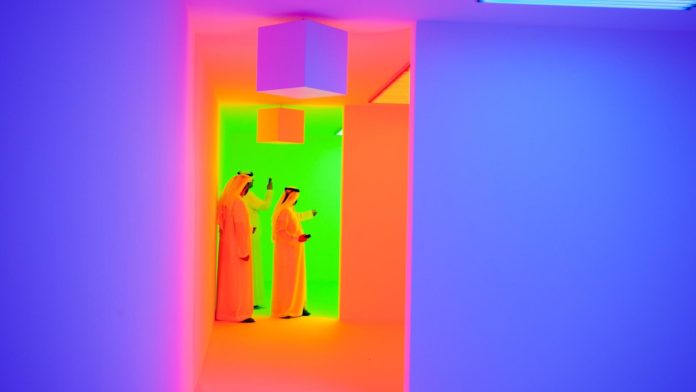Carlos Cruz-Diez (b. 1923, Caracas; d. 2019, Paris) is a major protagonist in the story of late 20th-century art. His investigations into the ever changing and ephemeral nature of color established him as one of the key pioneers of Kinetic and Optical art. Through his experimental use of light, movement, space, and viewer interactivity, Cruz-Diez encouraged “an awareness of the instability of reality” while proposing a new definition of art as a field of active participation.
Acquired for PAMM’s collection in 2020 with funds provided by Jorge M. Pérez, Chromosaturation is an immersive environment that reimagines color as an embodied experience. Initially conceived in 1965, the installation consists of three connected chambers infused with intensely saturated red, green, and blue light. Upon entering this space, visitors are transported by a chromatic experience that shifts as one moves from one space to the next. The experience scrambles the retina, which is normally accustomed to perceiving a wide range of colors simultaneously. Eliciting both a strong sensorial and emotional response in viewers, the installation transitions from a visual experience into a bodily one, underscoring the notion of color as a material, physical phenomenon that unfolds continuously in time and space.
Chromosaturation is emblematic of Cruz-Diez’s pioneering contribution to the experimental practices that emerged in the 1960s and 1970s, which proposed the dematerialization of the object in favor of participatory situations that engage the spectator’s body, senses, and subjectivity. Cruz-Diez’s experimentations with color and sensory perception anticipated many of the relational and participatory tendencies of recent art.
Carlos Cruz-Diez: Chromosaturation is organized by PAMM’s Andrew W. Mellon Caribbean Cultural Institute Coordinator Iberia Pérez González and PAMM’s Director of Curatorial Affairs and Chief Curator René Morales.
Chromosaturation (París 1965)
Estas obras se relacionan con la idea de que en el origen de toda cultura reposa un acontecimiento primario como punto de partida. Una situación simple que genera todo un sistema de pensamiento, una sensibilidad, mitos, etc.
English description.
La Chromosaturation es un ambiente artificial compuesto por tres cámaras de color, una roja, una verde y otra azul, que sumergen al visitante en una situación monocroma absoluta. Esta experiencia origina perturbaciones en la retina, habituada a percibir simultáneamente amplias gamas de colores. La Chromosaturation puede actuar como detonante activando en el espectador la noción del color en tanto que situación material, física, que sucede en el espacio sin la ayuda de la forma e incluso sin soporte alguno, independientemente de las convenciones culturales.
Carlos Cruz-Diez (b. 1923, Caracas; d. 2019, Paris) is a major protagonist in the story of late 20th-century art. His investigations into the ever changing and ephemeral nature of color established him as one of the key pioneers of Kinetic and Optical art. Through his experimental use of light, movement, space, and viewer interactivity, Cruz-Diez encouraged “an awareness of the instability of reality” while proposing a new definition of art as a field of active participation. Acquired for PAMM’s collection in 2020 with funds provided by Jorge M. Pérez, Chromosaturation is an immersive environment that reimagines color as an embodied experience. Initially conceived in 1965, the installation consists of three connected chambers infused with intensely saturated red, green, and blue light. Upon entering this space, visitors are transported by a chromatic experience that shifts as one moves from one space to the next. The experience scrambles the retina, which is normally accustomed to perceiving a wide range of colors simultaneously. Eliciting both a strong sensorial and emotional response in viewers, the installation transitions from a visual experience into a bodily one, underscoring the notion of color as a material, physical phenomenon that unfolds continuously in time and space. Chromosaturation is emblematic of Cruz-Diez’s pioneering contribution to the experimental practices that emerged in the 1960s and 1970s, which proposed the dematerialization of the object in favor of participatory situations that engage the spectator’s body, senses, and subjectivity. Cruz-Diez’s experimentations with color and sensory perception anticipated many of the relational and participatory tendencies of recent art.




